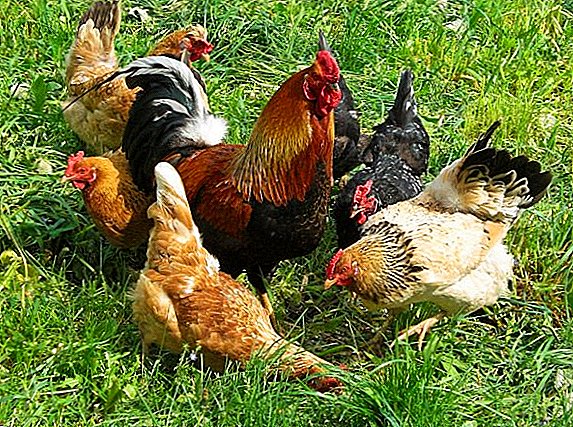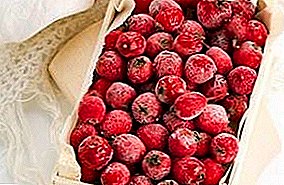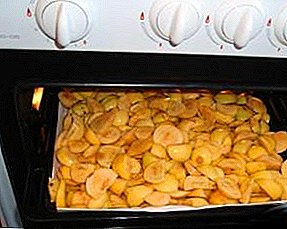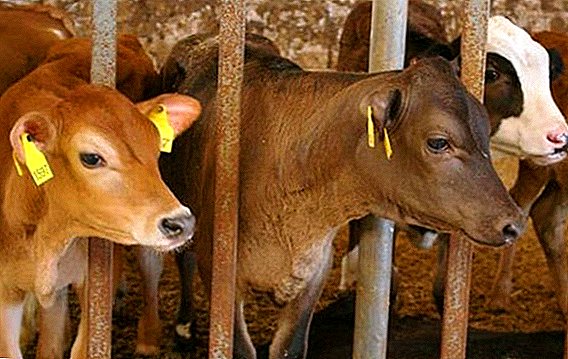 The young bull’s body weight is a very important indicator of its health. Therefore, in the first time after birth, it is important to monitor the weight of the calf, and if there are any deviations from the norm, make adjustments to the diet.
The young bull’s body weight is a very important indicator of its health. Therefore, in the first time after birth, it is important to monitor the weight of the calf, and if there are any deviations from the norm, make adjustments to the diet.
In our article, we will acquaint you with the rules by weight and tell you what food is most appropriate for young animals.
What is the weight of the calf at birth
The weight of a newborn calf is about 40 kg. During the following weeks weight gain occurs, and within a month its weight should be about 80 kg.
Important! When feeding calves with milk from a bottle, it is necessary to warm it up to 38 °WITH.
However, it is not necessary to equate all animals under one parameter, since the weight gain depends on the breed of parents and the individual characteristics of the baby. Normally, the calf's live weight should be 7-9% of the mother's weight. 
How to find out the weight of a calf without scales
Today, there are several methods by which you can determine the weight of an animal without using weights. Consider them and give the standard values.
It will also be useful for you to find out which vitamins calves need for rapid growth and why the calf is sluggish and does not eat well.
By the method of Trukhanovsky
With this method, the measurement of chest girth beyond the area of the shoulder blades and the length of the body in a straight line is carried out. To do this, use a stick, ruler or centimeter. After that, the obtained 2 values must be multiplied, divided by 100 and multiplied by the correction factor. For dairy animals, it is 2, and for meat and dairy-meat it is necessary to apply a factor of 2.5. 
According to the Kluwer-Strauch method

According to the Freumen method
| Girth, in cm | Length, cm | |||||||||
| 50 | 52 | 54 | 56 | 58 | 60 | 62 | 64 | 66 | 68 | |
| Live weight, in kg | ||||||||||
| 62 | 16,1 | 16,5 | 16,9 | 17,7 | 18,5 | 19,5 | 20,5 | 21,5 | 22,0 | 23 |
| 64 | 16,9 | 17,7 | 18,5 | 19,3 | 20,1 | 20,9 | 21,7 | 22,5 | 23,3 | 24 |
| 66 | 18,1 | 18,9 | 19,7 | 20,5 | 21,3 | 22,1 | 22,9 | 23,7 | 24,5 | 25 |
| 68 | 19,8 | 20,6 | 21,4 | 22,2 | 23,0 | 23,8 | 24,6 | 25,4 | 26,2 | 27 |
| 70 | 22,0 | 22,8 | 23,6 | 24,4 | 25,2 | 26,0 | 26,8 | 27,6 | 28,4 | 29 |
| 72 | 23,7 | 24,5 | 25,3 | 26,1 | 26,9 | 27,7 | 28,5 | 29,3 | 30,1 | 30 |
| 74 | 25,9 | 26,7 | 27,5 | 28,3 | 29,1 | 29,9 | 30,7 | 31,5 | 32,3 | 33 |
| 76 | 28,1 | 28,9 | 29,7 | 30,5 | 31,3 | 32,1 | 32,9 | 33,7 | 34,5 | 35 |
| 78 | 30,3 | 31,1 | 31,9 | 32,7 | 33,5 | 34,3 | 35,1 | 35,9 | 36,7 | 37 |
| 80 | - | 31 | 32 | 33 | 34 | 35 | 36 | 37 | 38 | 39 |
| 82 | - | 33 | 34 | 35 | 36 | 37 | 38 | 39 | 40 | 41 |
| 84 | - | - | 36 | 37 | 38 | 39 | 40 | 41 | 42 | 43 |
| 86 | - | - | - | 40 | 41 | 42 | 43 | 44 | 45 | 46 |
| 88 | - | - | - | - | 43 | 44 | 45 | 46 | 47 | 48 |
| 90 | - | - | - | - | - | 45 | 46 | 47 | 49 | 50 |
| 92 | - | - | - | - | - | - | 50 | 51 | 52 | 54 |
| 94 | - | - | - | - | - | - | - | 55 | 56 | 57 |
| 96 | - | - | - | - | - | - | - | - | 59 | 60 |
| 98 | - | - | - | - | - | - | - | - | - | 64 |
| Girth, in cm | Length, cm | |||||||||
| 70 | 72 | 74 | 76 | 78 | 80 | 82 | 84 | 86 | 88 | |
| Live weight, in kg | ||||||||||
| 64 | 24,9 | - | - | - | - | - | - | - | - | - |
| 66 | 26 | 27 | - | - | - | - | - | - | - | - |
| 68 | 28 | 29 | 30 | - | - | - | - | - | - | - |
| 70 | 30 | 31 | 32 | 33 | - | - | - | - | - | - |
| 72 | 31,7 | 32 | 33 | 34 | 35 | - | - | - | - | - |
| 74 | 34 | 35 | 36 | 36 | 37 | 38 | - | - | - | - |
| 76 | 36 | 37 | 38 | 39 | 39 | 40 | 41 | - | - | - |
| 78 | 38 | 39 | 40 | 41 | 42 | 42 | 43 | 44 | - | - |
| 80 | 40 | 41 | 42 | 43 | 44 | 45 | 46 | 47 | 48 | - |
| 82 | 42 | 43 | 44 | 45 | 46 | 47 | 48 | 49 | 50 | 51 |
| 84 | 44 | 45 | 46 | 47 | 48 | 49 | 50 | 51 | 52 | 53 |
| 86 | 47 | 48 | 49 | 50 | 51 | 52 | 53 | 54 | 55 | 56 |
| 88 | 49 | 50 | 51 | 52 | 53 | 54 | 55 | 56 | 57 | 58 |
| 90 | 51 | 52 | 53 | 55 | 56 | 57 | 58 | 59 | 61 | 62 |
| 92 | 55 | 56 | 57 | 58 | 60 | 61 | 62 | 63 | 64 | 66 |
| 94 | 58 | 59 | 61 | 62 | 63 | 64 | 65 | 67 | 68 | 69 |
| 96 | 61 | 63 | 64 | 65 | 66 | 67 | 69 | 70 | 71 | 72 |
| 98 | 65 | 66 | 68 | 69 | 70 | 71 | 72 | 74 | 75 | 76 |
| 100 | 66 | 67 | 69 | 70 | 71 | 73 | 74 | 76 | 77 | 79 |
| 102 | - | 71 | 72 | 74 | 75 | 77 | 78 | 79 | 81 | 82 |
| 104 | - | - | 77 | 78 | 80 | 81 | 83 | 84 | 85 | 87 |
| 105 | - | - | - | 84 | 85 | 86 | 88 | 89 | 91 | 92 |
| 108 | - | - | - | - | 91 | 92 | 93 | 95 | 96 | 98 |
| 110 | - | - | - | - | - | 98 | 99 | 100 | 102 | 103 |
| 112 | - | - | - | - | - | - | 104 | 105 | 107 | 108 |
| 114 | - | - | - | - | - | - | - | 111 | 112 | 114 |
| 116 | - | - | - | - | - | - | - | - | 118 | 119 |
| 118 | - | - | - | - | - | - | - | - | - | 121 |
| Girth, in cm | Length, cm | |||||||||
| 90 | 92 | 94 | 96 | 98 | 100 | 102 | 104 | 106 | 108 | |
| Live weight, in kg | ||||||||||
| 84 | 54 | - | - | - | - | - | - | - | - | - |
| 86 | 57 | 58 | - | - | - | - | - | - | - | - |
| 88 | 59 | 60 | 61 | - | - | - | - | - | - | - |
| 90 | 63 | 64 | 65 | 67 | - | - | - | - | - | - |
| 92 | 67 | 68 | 69 | 70 | 72 | - | - | - | - | - |
| 94 | 70 | 71 | 73 | 74 | 75 | 76 | - | - | - | - |
| 96 | 73 | 75 | 76 | 77 | 78 | 79 | 81 | - | - | - |
| 98 | 77 | 78 | 80 | 81 | 82 | 83 | 84 | 86 | - | - |
| 100 | 80 | 84 | 83 | 84 | 86 | 87 | 88 | 90 | 91 | - |
| 102 | 84 | 85 | 86 | 88 | 89 | 91 | 92 | 93 | 95 | 96 |
| 104 | 88 | 90 | 91 | 92 | 94 | 95 | 97 | 98 | 99 | 101 |
| 106 | 93 | 95 | 98 | 98 | 99 | 100 | 102 | 103 | 104 | 106 |
| 108 | 99 | 100 | 102 | 103 | 105 | 106 | 107 | 109 | 110 | 112 |
| 110 | 105 | 106 | 107 | 109 | 110 | 112 | 113 | 114 | 116 | 117 |
| 112 | 110 | 111 | 112 | 114 | 115 | 117 | 118 | 119 | 121 | 122 |
| 114 | 115 | 117 | 118 | 119 | 121 | 122 | 124 | 125 | 126 | 128 |
| 116 | 121 | 122 | 124 | 125 | 126 | 128 | 129 | 131 | 131 | 133 |
| 118 | 123 | 124 | 126 | 127 | 129 | 131 | 132 | 134 | 135 | 137 |
| 120 | 129 | 130 | 132 | 133 | 135 | 137 | 138 | 140 | 141 | 143 |
| 122 | 135 | 136 | 138 | 139 | 141 | 142 | 143 | 145 | 146 | |
| 124 | 142 | 144 | 145 | 147 | 148 | 150 | 152 | 153 | ||
| 126 | 150 | 152 | 153 | 155 | 156 | 158 | 160 | |||
| 128 | 158 | 160 | 161 | 163 | 164 | 166 | ||||
| 130 | 166 | 168 | 169 | 170 | 172 | |||||
| 132 | 171 | 173 | 175 | 179 | ||||||
| Girth, in cm | Length, cm | |||||||||
| 90 | 92 | 94 | 96 | 98 | 100 | 102 | 104 | 106 | 108 | |
| Live weight, in kg | ||||||||||
| 104 | 102 | - | - | - | - | - | - | - | - | - |
| 106 | 107 | 109 | - | - | - | - | - | - | - | - |
| -108 | 113 | 114 | 116 | - | - | - | - | - | - | - |
| 110 | 119 | 120 | 121 | 123 | - | - | - | - | - | - |
| 112 | 124 | 125 | 126 | 128 | 130 | - | - | - | - | - |
| 114 | 129 | 131 | 132 | 133 | 135 | 136 | - | - | - | - |
| 116 | 135 | 136 | 138 | 139 | 140 | 142 | 143 | - | - | - |
| 118 | 139 | 140 | 142 | 143 | 145 | 147 | 148 | 150 | - | - |
| 120 | 145 | 146 | 148 | 149 | 151 | 153 | 154 | 156 | 157 | - |
| 122 | 148 | 150 | 151 | 153 | 155 | 157 | 159 | 160 | 162 | 163 |
| 124 | 155 | 156 | 158 | 160 | 161 | 163 | 164 | 166 | 168 | 169 |
| 126 | 161 | 163 | 164 | 166 | 168 | 169 | 171 | 172 | 174 | 176 |
| 128 | 168 | 169 | 171 | 172 | 174 | 176 | 177 | 179 | 180 | 182 |
| 130 | 174 | 176 | 177 | 179 | 180 | 182 | 184 | 185 | 187 | 188 |
| 132 | 178 | 180 | 182 | 184 | 185 | 187 | 189 | 191 | 193 | 194 |
How to feed the bulls for quick weight gain
In order for animals to gain weight in accordance with the standards, it is very important to adhere to certain rules and a healthy diet. Consider them. 
Feeding newborn calves
After the calving of cows occurs, it is very important to feed the young animals with the help of colostrum. It contains vitamins and minerals that contribute to the creation and maintenance of a strong and healthy immunity of the calf.
Did you know? For the first time domesticated cows began even 8 thousand years ago.
It differs from milk in that it contains a greater amount of protein, which is necessary for a young growing organism.
By following simple guidelines you can grow healthy animals:
- ensure the feeding of newborn babies 6 times a day;
- gradually reduce the frequency of feeding - by the 30th day of birth, it should be 3 times a day;
- give the animal a collection of milk;
- feed the babies with the help of the nipple (after each meal, it is disinfected);
- add vitamins to food.
 With the right approach to feeding, the weight of young calves by the 30th day of birth should increase by 15 kg.
With the right approach to feeding, the weight of young calves by the 30th day of birth should increase by 15 kg.Learn more about the calf feeding stages.
The transition to solid food
Starting from the 2nd month, solid food, which is saturated with proteins, fats and carbohydrates, should be introduced into the diet of a bull. The most common use of starter feed, which every day is gradually introduced into the menu and gradually replaces milk feeding.
Despite the fact that by this age a bull may have 2 times the mass from birth, the gastrointestinal tract does not work properly yet and this should be taken into account when feeding with solid food. It is thanks to the compound feed that the transition to solid food is softer.
It has the required amount:
- ground corn, wheat, barley;
- skimmed milk powder;
- meal;
- fodder yeast;
- feed fat;
- sugar and salt.
 A couple of weeks after the initial feed was introduced, a handful of hay should be added to the calves' diet, gradually increasing it by 200 g. In addition, haylage should be present in the diet.
A couple of weeks after the initial feed was introduced, a handful of hay should be added to the calves' diet, gradually increasing it by 200 g. In addition, haylage should be present in the diet.Important! It is recommended to make measurements several times and then calculate the average indicators, as the animal can spin.
Fattening for slaughter
If calves are raised for slaughter, farmers use several animal feeding schemes. Consider them.
- Short circuit. Lasts from 1 to 3 months. Most often used for fattening large animals, which themselves do not need a large weight gain. Starting the event is at the age of one and a half months.
- Medium pattern. It is worthwhile to start fattening animals according to this scheme when it reaches the age of 1, 3-1.6 months. Fattening lasts 4-7 months. As a result, the mass of the bull may increase by 150 kg.
- Long scheme. It takes 8-12 months. At the same time feeding should be moderate. The result is an increase in mass up to 300-350 kg.
 In addition to the choice of scheme, it is necessary to adhere to the following recommendations:
In addition to the choice of scheme, it is necessary to adhere to the following recommendations:- the animal should move as little as possible;
- the diet should contain food that contains proteins, carbohydrate fats - you can use feed, fresh grass, hay, and food waste;
- In the diet should be brewer's grains and vitamins.
Did you know? In 30 seconds, the jaws of a cow can make 90 movements.
Feeding and maintaining young bulls can only be effective if the recommendations are followed. Watch the behavior of the animal, and you can achieve good performance.












